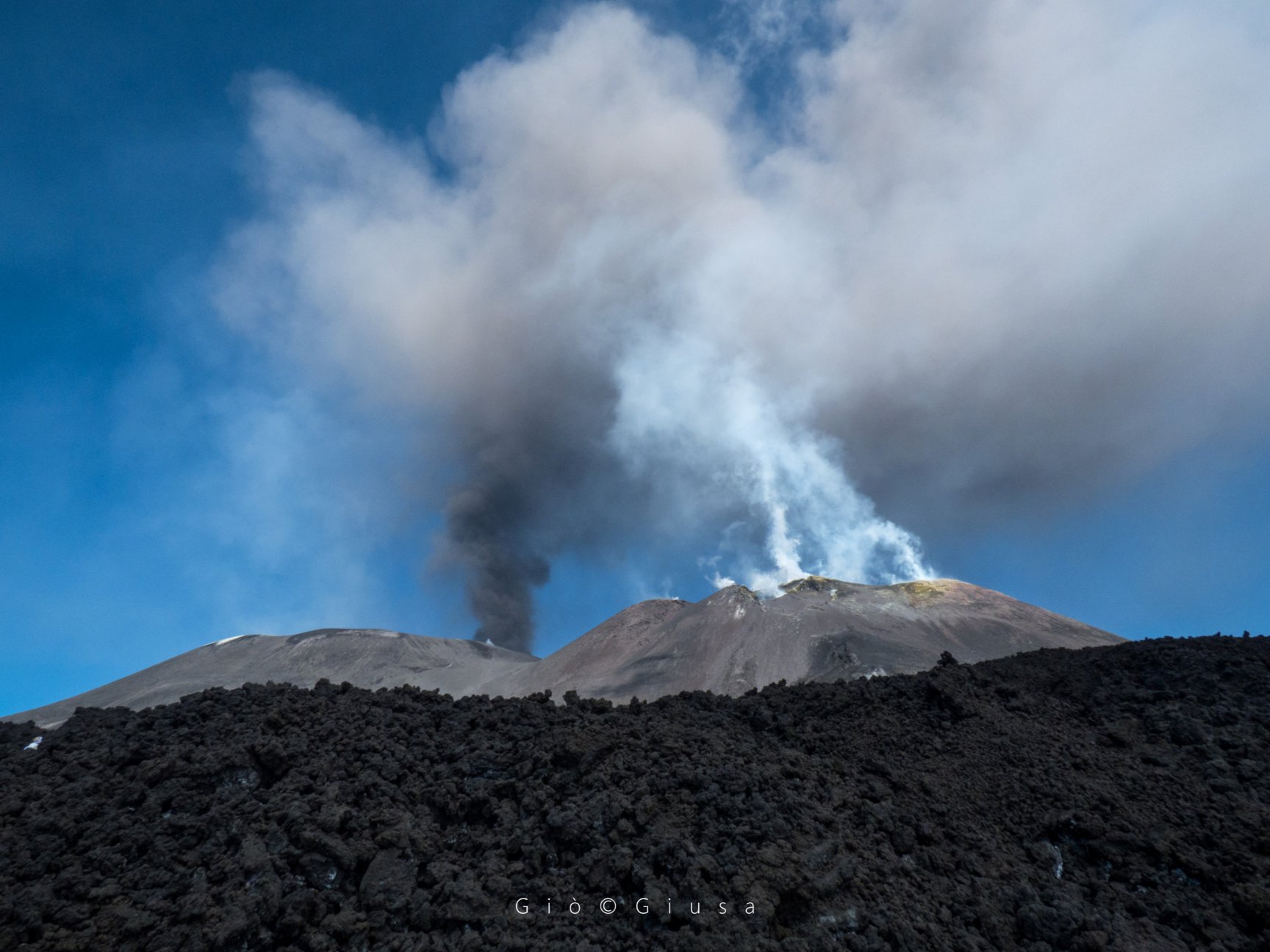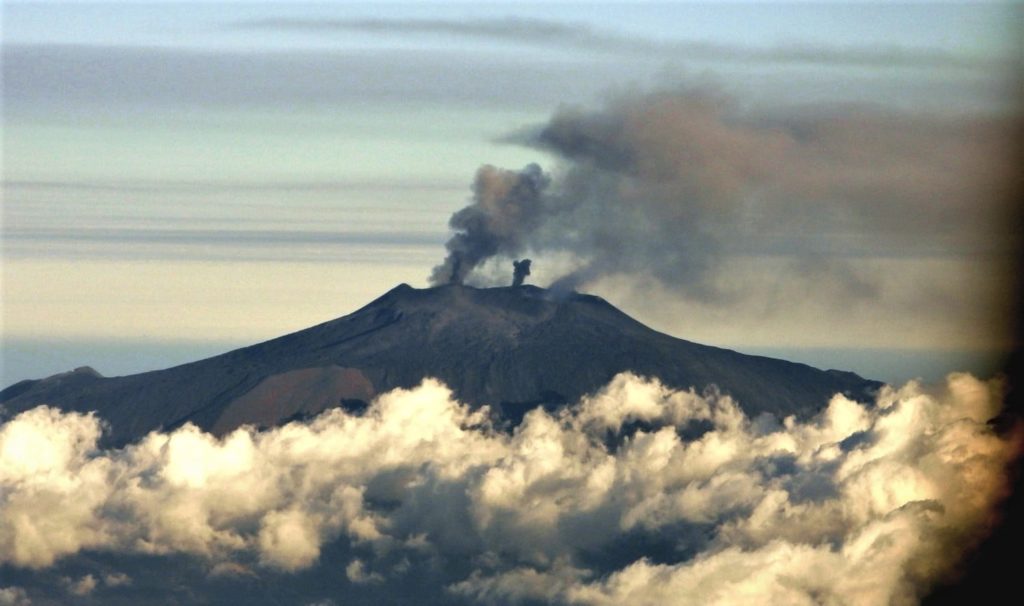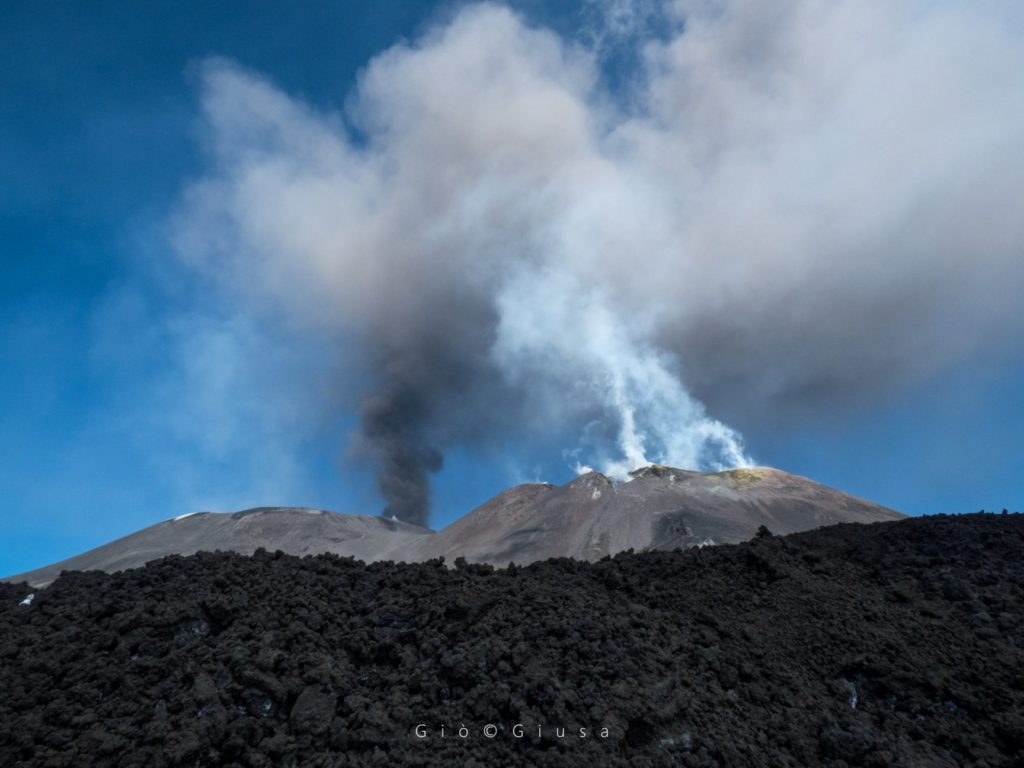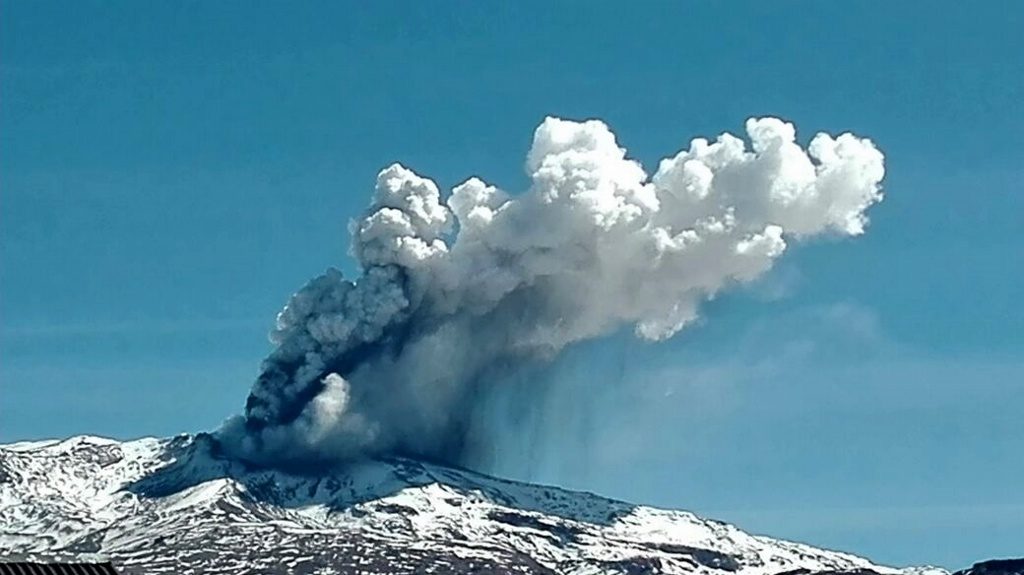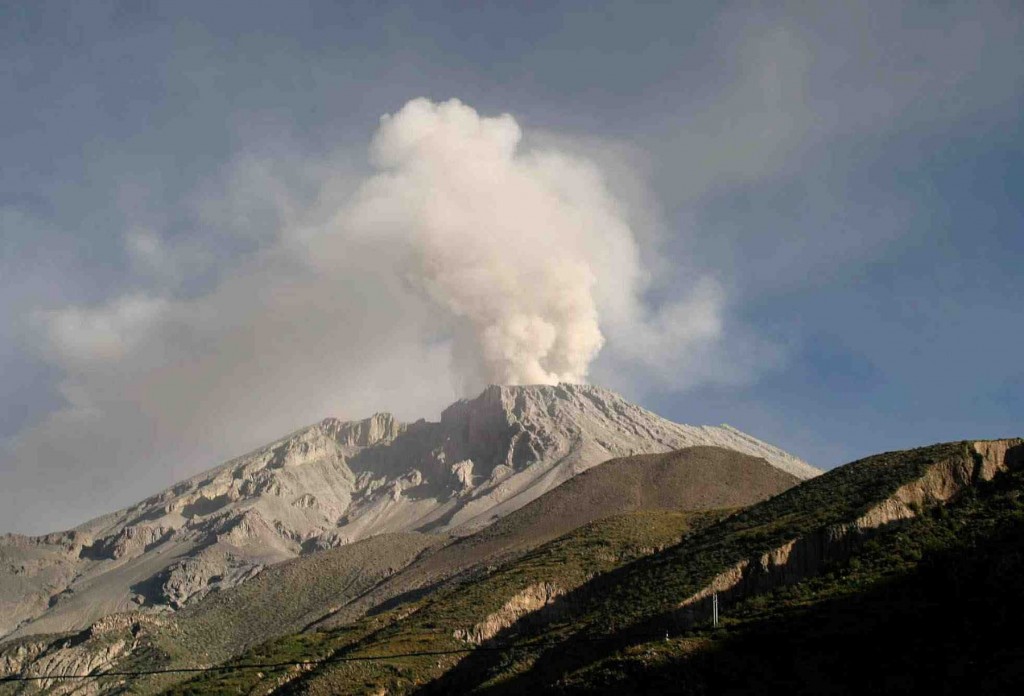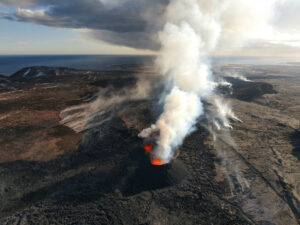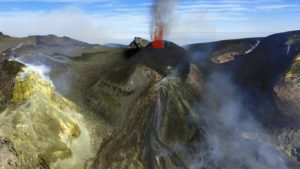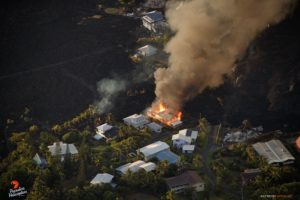October 02 , 2019.
Italy / Sicily , Etna :
VOLCANIC ACTIVITY REPORT, ETNA, OCTOBER 1, 2019, 07:05:55 (UTC).
The National Institute of Geophysics and Volcanology, Osservatorio Etneo, announces that the images of the network of surveillance cameras show a pulsating emission of ash on the craters of the summit. The amplitude of the volcanic tremor is maintained on the average values.
Aerial view of Etna, seen from the West in the afternoon of September 30, 2019. On the left, the plume of ash emitted by the crater Northeast, in the center a puff generated by one of the explosions of the crater of Voragine.
VOLCANIC ACTIVITY REPORT FOR ETNA, 1 OCTOBER 2019, 08:55:09 h UTC (10:55:09 h local time)
The Istituto Nazionale di Geofisica e Vulcanologia, Osservatorio Etneo, reports that since about 08:50 h GMT, the images of the surveillance cameras are showing an intensification of the ash emission described in the previous communiqué. The volcanic tremor amplitude does not show significant variations compared to the previous update.
VOLCANO OBSERVATORY NOTICE FOR AVIATION (VONA)
Issued: October 01 , 2019 .
Volcano: Etna 211060
Current Color Code: RED
Previous Color Code: orange
Source: Etna Volcano Observatory
Notice Number: 2019/0075/06E01
Volcano Location: 3744N 01500E (
Area: Italy
Summit Elevation: 3300 m
Volcanic Activity Summary:
EXPLOSIVE ACTIVITY IS OBSERVED AT SUMMIT CRATERS, ASH EMISSION ONGOING
Volcanic cloud height:
EXSTIMATED VOLCANIC CLOUD HEIGHT IS 5000 AT THE TOP; DATA FROM SURVELLIANCE CAMERAS (13) Other volcanic cloud information: GREY COLOUR CLOUD; BENT OVER SHAPE PLUME
Remarks:
THE PHENOMENON IS DETECTED BY VISIBLE AND THERMAL SURVEILLANCE CAMERAS
Next Notice:
A new VONA will be issued if conditions change significantly or color code changes. Volcano information and updates are posted at http://www.ct.ingv.it/it/vona.html
ETNA Weekly Newsletter 23 September 2019 – 29 September 2019 (publication date 01 October 2019)
SUMMARY OF ACTIVITY
In light of the surveillance data, we highlight:
VOLCANOLOGICAL OBSERVATIONS: Strombolian activity in the crater of Voragine (VOR). Strombolian intra-crateric activity in the crater of La Bocca Nuova (BN). Ash emissions from the northeast crater (NEC). Ordinary degassing activity of the new southeastern crater (NCSE).
SISMOLOGY: Modest seismic activity due to fracturing; amplitude of volcanic tremor variable between high and medium levels.
INFRASONS: quite high infrasonic activity.
DEFORMATIONS: Etna soil deformation monitoring networks did not reveal any significant variation in reporting over the last week.
GEOCHIMY: SO2 flows are at an average level. Terrestrial CO2 fluxes show a slight downward trend and remain low. The partial pressure of CO2 in the soil does not show any significant changes. The helium isotope ratio values show an additional decrease reaching medium-high values (latest data available on 25 September).
VOLCANOLOGICAL OBSERVATIONS
The monitoring of crater volcanic activity at the summit of Mount Etna during the week was carried out by analyzing the images of the surveillance camera network of the INGV section – Catania, Osservatorio Etneo (INGV-OE). During the period under review, Etna’s activity was characterized by explosive Strombolian activity in the Voragine crater (VOR), Strombolian intrafarteric activity in the Bocca Nuova crater (BN) and by ash emissions, sometimes accompanied by incandescence, to the Northeast Crater (NEC). The new Crater du Sud-Est was rather affected by an ordinary degassing activity.
In particular, the intense Strombolian activity affecting the crater of Voragine since September 12 has continued. The Northeast Crater has been characterized, in addition to an intense and continuous degassing activity, by the resumption of ashes emissions, even important, such as those observed in the early morning hours of September 27th. Immediately after 0500 GMT, the Northeast Crater released an ash emission that generated a plume that dispersed to the southern quadrants of the volcano. Activity then quickly quieted almost completely about an hour later.
Moreover, in the early morning hours of September 24, the high resolution camera of Monte Cagliato, showed clearly visible lights, at the same time as Strombolian activity that interested the crater of Voragine. The crater of the Bocca Nuova (BN), according to the observations made by the volcanological guides, was affected by an intra-crateric Strombolian activity. Finally, the new crater of the southeast has been affected by ordinary degassing activities … / …
Source : INGV
Read the full article : file:///C:/Users/Utilisateur/AppData/Local/Packages/Microsoft.MicrosoftEdge_8wekyb3d8bbwe/TempState/Downloads/Bollettinoetna20191001%20(1).pdf
Photos : INGV , Gio Giusa .
Vidéo : Michele Mammino.
Chile , Copahue :
Special Volcanic Activity Report (REAV) Bio Bio Region, Copahue Volcano, 01 October 2019, 07:00 Local Time (Continental Chile).
The National Geological and Mining Service of Chile (Sernageomin) discloses the following PRELIMINARY information, obtained through monitoring equipment of the National Volcanic Monitoring Network (NVRN), processed and analyzed at the Volcanological Observatory of the South Andes (OVDAS) ):
Yesterday, Tuesday 1 October at 06:28 local time (09:28 UTC), the monitoring stations installed near the Copahue volcano recorded an earthquake associated with the fracturing of the rock (Volcano-Tectonic type).
The characteristics of the earthquake after its analysis are as follows:
TIME OF ORIGIN: 06:28 local time (09:28 UTC)
LATITUDE: 37.834 ° S
LONGITUDE: 71,068 ° W
DEPTH: 4.6 km
LOCAL MAGNITUDE: 3.7 (ML).
OBSERVATIONS:
At the time of publication of this report, the phenomenon of VT-type seismicity is continuing, recording 14 low-energy events in the same area, the largest of which is of magnitude 2.4.
The volcanic technical alert is maintained at the level: orange
Sernageomin monitors online and informs in a timely manner of possible changes in volcanic activity.
The Copahue volcano shook again and it was declared the orange technical alert
During this afternoon, « long period type earthquakes with high energies and abundant seismicity were recorded.
The Chilean agency has decided to launch the technical alert at the Orange level and to declare an exclusion radius of five kilometers around the crater.
Due to the increase in activity, the Sernageomin authorities have organized a technical table to analyze the situation.
According to the Chile Seismology organization, some of these earthquakes have been reported in the city of Caviahue.
City Mayor Oscar Mansegosa said that in Caviahue both earthquakes had been reported (one of 4.1 and one of 3.8), but he noticed that this type of telluric movement had occurred on other occasions.
Mansegosa recalled that the orange technical alert is a type of alert aimed at activating the protocols of the civil defense and surveillance agencies, and said that this was not yet a case of alerting the population.
At this moment it is snowing in the city. During this afternoon, it fell from 10 to 12 millimeters and the sky is completely covered, so it is not possible to see the volcano.
Source : Sernageomin , rionegro.com.ar
Photo : Auteur inconnu
Peru : Sabancaya ,
Period of analysis: from 23 to 29 September 2019. Arequipa, September 30, 2019.
Alert level: ORANGE
The Geophysical Institute of Peru (IGP) reports that the eruptive activity of the Sabancaya volcano has remained at moderate levels; that is, with the recording of continuous moderate explosions and resulting ash emissions. Therefore, for the following days, no significant change in activity is expected.
The analysis of records obtained with the seismic network of the Sabancaya volcano for the period from 23 to 29 September 2019 has identified the presence of about 3017 earthquakes of volcanic origin, the highest percentage of which is associated with the magmatic fluid movement under the volcano . During this week, there was an average of 15 daily explosions of medium to low intensity.
The monitoring of the deformation of the volcanic structure, using GNSS data (processed with fast orbits), does not show significant anomalies related to a deformation. On the other hand, the visual surveillance, using surveillance cameras, made it possible to identify the appearance of columns of gas and ash up to 1.7 km high on the summit of the volcano, which dispersed to the West, North-West and South-West sectors of Sabancaya. Satellite monitoring identified 11 thermal anomalies with values between 10 and 55 MW, associated with the presence of a hot body near the surface of the volcano crater.
Source : Cenvul.
Photo : Auteur inconnu
La Réunion , Piton de la Fournaise :
Seismicity:
In September 2019, the OVPF recorded at the level of the Piton de la Fournaise massif in total:
28 superficial volcano-tectonic earthquakes (0 to 2 km deep) beneath the summit craters;
4 deep earthquakes (> 2 km deep);
352 collapses (in the Crater Dolomieu and the remparts of Enclos Fouqué).
Seismicity under the Piton de la Fournaise during the month of September 2019 remained low with an average of a superficial volcano-tectonic earthquake per day. Four deep earthquakes have also been recorded under the eastern flank.
Deformation:
Inflation (swelling) of the building that had resumed following the end of the eruption of 11-15 August 2019 stopped in early September 2019.
Geochemistry of gases.
CO 2 concentration in the soil:
In the far field (Plaine des Cafres and Plaine des Palmistes areas): Since the eruption of 11-13 June, CO2 flows have fallen to low values in the last month.
Composition of summit fumaroles by MultiGas method:
Since its resettlement on 06 September, the MultiGas station at the top shows a continuing trend of increasing CO2 concentrations and a decrease in the CO2 / SO2 ratio which could indicate a gradual degassing of the magma at decreasing pressure.
SO 2 flux in the air in the Enclos Fouqué by DOAS method:
Below the detection threshold.
Phenomenology :
No eruptive activity was observed during the month of September 2019.
Balance sheet:
The month of September 2019 will have been marked in the Piton de la Fournaise by a low seismicity under the summit craters and a stop of the inflation of the building. This is indicative of stopping (or at least slowing down because an increase in CO2 concentrations at the top is still observed) magmatic transfers from the deep areas to the more superficial areas.
Source : OVPF.
Read the full article : http://www.ipgp.fr/sites/default/files/ovpf_20191001_bullmensu.pdf
Photo : Bernard Duyck.

